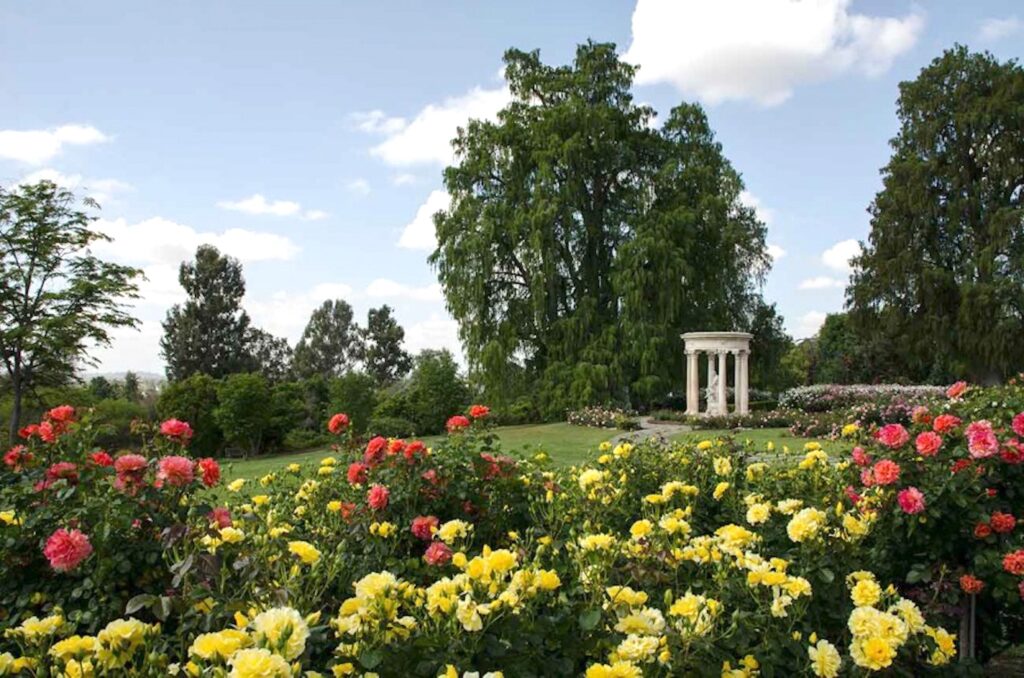Most museums remain closed as the coronavirus pandemic continues to impact every aspect of life, but many botanical gardens have reopened, offering a welcome oasis of beauty and tranquility during this challenging time.
Museums and botanical gardens must meet more than 60 coronavirus health and safety requirements in five categories before they can reopen. These include eliminating access to interactive exhibits, implementing mandatory reservations and timed entries to limit the number of visitors present at any one time. Botanical gardens have a big advantage over museums because the outdoor environment makes it easier to implement the safety measures.
Visitors to all botanical gardens are required to wear cloth face coverings, practice social distancing, and be willing to be screened for COVID-19 symptoms, including a temperature check. It’s a good idea to bring water, most food service is closed and drinking fountains are unavailable. Disabled visitors and families with young children should plan to bring their own wheelchairs and strollers, since rentals may not be available.
This is the ideal time to buy a membership to a favorite botanical garden. Members often receive priority ticketing and benefits like special hours, and it is a way to help support institutions that are facing unexpected and often crushing expenses during the coronavirus crisis.

Descanso Gardens in La Cañada Flintridge was one of the first major botanical gardens to reopen in mid May. Access to the 120-acre garden, famous for its tree-shaded paths and displays of roses and other flowers, is open by reservation only. General admission is $15. Seniors and students with ID, $11; Children (5-12) $5. Descanso members and children under 5 free. The garden is open 9 a.m.-8 p.m. daily. 1418 Descanso Drive, La Cañada Flintridge, CA 91011.

The Huntington Library in San Marino is still closed, but much of the world-famous Huntington Botanical Gardens, which cover more than 200 acres, reopened July 1, by reservation only.
“Getting to this moment where we can open our gardens to visitors again has been a remarkable journey and a very careful process,” said Huntington President Karen R. Lawrence. “We have spent considerable time developing our safety protocols to protect our staff, our members, and the public. We know our visitors can’t wait to walk our paths again, and we can’t wait to welcome them back.”
Extra hours have been added to help accommodate visitors. Restrooms are available, but food service and water fountains are not. General admission is $25 weekdays, $29 weekends for adults; $21/$24 for seniors, students and active military; $13 for children 4-11; under 4, free. Parking is free. 1151 Oxford Road, San Marino, 91108, 626-405-2100.
You have to drive a little farther to reach the Los Angeles County Arboretum, located east of the Huntington in the city of Arcadia, but it’s worth the pilgrimage to visit this historic 127-acre paradise of gardens, woodland, and water features.
Restrooms and grab-and-go food are available; drinking fountains are not. Reservations are required. Adults, $15; students with ID and Seniors age 62 and older, $11; children ages 5-12, $5; children 4 and under, free. 301 North Baldwin Avenue, Arcadia, 91007.
Exotic and surreally beautiful Lotusland in Montecito, just outside of Santa Barbara, is another great day trip option. Docent-led and self-guided tours are available by reservation only.
This garden, with its strange and wonderful series of tropical and subtropical gardens, was the home of opera singer and grand dame Ganna Walska. It is located in a residential neighborhood and access has always been limited to a small number of visitors at a time.
Admission is $50 for adults; $25 for ages 3 to 17; 2 and under, free. Admission fees are non-refundable. Call for reservations: 805.969.9990.
Two smaller botanical gardens closer to home have also reopened. UCLA’s Mildred E. Mathais Botanical Garden is a lush 7.5-acre oasis in the middle of West L.A. that features a forest of ancient plants dinosaurs might have grazed on, tropical and desert gardens, ferns and wildflowers.
The garden is open daily for self-guided tours. Monday – Friday, 8 a.m. to 5 p.m. Saturday – Sunday: 9 a.m. to 5 p.m. Restrooms are closed, so plan accordingly. The main entrance is located at the La Kretz Garden Pavilion, 707 Tiverton Ave., Los Angeles 90095. Parking is limited, but visitors can park in UCLA Visitor Parking Structure 2 (make sure to pay on arrival to avoid being ticketed). Admission to the garden is free.
The Conejo Valley Garden in Thousand Oaks combines a pleasant hiking trail along an oak-shaded creek and 15 specialty gardens that range from native plants to an orchard of rare fruits.
The 33-acre garden is open sunrise to sunset daily. The only restrooms currently available are portable toilets. Admission is free, but donations and memberships are welcomed. This is the only botanical garden we know of where dogs are welcome as long as they are leashed. Conejo Valley Botanical Garden, 400 W. Gainsborough Rd., Thousand Oaks, 91360.
In a summer without vacations, movies, theater, or museums, botanical gardens offer a welcome escape for a day, an afternoon, or even just an hour.













